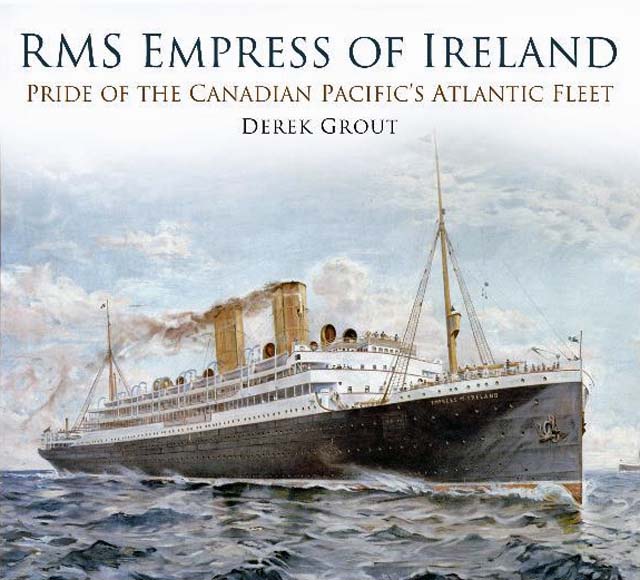|
The cover of a book by Derek Grout - Date unknown Anonymous Artist.
1 March 2015
Victoria Doctor Had Key Role
in Ocean Liner's Tragedy
Victoria Vancouver Island British Columbia - For many years, Victoria was a key port for trans-Pacific ships operated by Canadian
Pacific Railway (CP).
The ocean-going vessels that came to Victoria and Vancouver played a vital role in linking England to the outer reaches of the Commonwealth.
With ships on the Atlantic and Pacific oceans, along with the railway across the country, the company had created what it claimed was the greatest
transportation system in the world.
In 1887, CP ships started runs connecting our coast to Hong Kong and Yokohama, Japan.
In 1903, it bought several liners to provide an Atlantic service as well.
The end result was a relatively simple connection from Liverpool to the Far East.
There were several accidents and incidents with the Pacific fleet, but nothing that compared to the disaster of the Empress of Ireland in the St. Lawrence
River in May 1914.
The ocean liner sank after a collision with the Norwegian collier Storstad.
There were 1,477 people on the CP liner, and 1,012 of them died, going down with the ship within sight of land.
It was the greatest peacetime maritime disaster in Canadian history.
The loss of the Empress of Ireland occurred just two years after the Titanic went down.
Several people from Victoria were on board, including the ship's doctor, James Frederick Grant.
He was able to escape the sinking vessel, and was praised for helping other survivors who needed immediate medical attention.
Lavishly illustrated, the book builds a strong history of the liner and the role it played in CP's commitment to transportation.
Author Derek Grout also describes in great detail the accident that led to the loss of the vessel, as well as subsequent pillaging of the
shipwreck.
The Empress of Ireland was built by Fairfield Shipbuilding and Engineering at Govan on the Clyde in Scotland, the yard that also built several vessels for the
Pacific and coastal services.
It was launched in 1906, and in 96 sailings across the Atlantic, it brought almost 120,000 immigrants to North America.
It plays a crucial role, therefore, in many Canadian family histories.
The ship provided cabins for third-class passengers, a great step up from the steerage classes on other lines.
Steerage was effectively a large dormitory, individual cabins made the trip much more acceptable to the passengers.
This book includes descriptions of the ship and its trips across the Atlantic, provided by some of those former passengers.
The summer port of the Empress vessels was Quebec City, since they could not get all the way up the St. Lawrence to Montreal.
These liners helped establish Quebec City as the most important immigration port in Canada.
Soon after the Empress of Ireland went down, the world was plunged into a great war, and the loss was almost forgotten.
It is not as well remembered as the Titanic before it, and the Lusitania after it, although the death tolls from all three were so high they are hard to
comprehend.
Grout's book is a highly readable account of the ship and her fate.
It will help to ensure that the Empress of Ireland is not forgotten.
Dave Obee.
|


